Dissolved Oxygen Prediction Model for the Yangtze River Estuary Basin Using IPSO-LSSVM
Abstract
1. Introduction
2. Materials and Methods
2.1. LSSVM Theory
2.2. Function Optimization Based on PSO Algorithm
3. Case Study
3.1. Data Source and Pre-Processing
3.2. Determining the Environmental Factors Affecting DO
3.3. PSO-LSSVM Predictive DO Combination Model
- 1.
- Using the 432 data samples after processing and selection, the readings were divided 7:3 into the training set (302) and test set (130);
- 2.
- IPSO with LSSVM model parameters were initialized. The number of particle populations was set to 10, the number of iterations was 50, and the learning factors and , respectively. The regularization parameters and kernel width were limited to [10, 1000], and the kernel function was RBF;
- 3.
- The fitness values of all particles in the particle swarm, IPSO algorithm updates pbest and gbest, as well as position and velocity were calculated;
- 4.
- The optimal value obtained by the IPSO algorithm was substituted into the LSSVM model to establish the IPSO-LSSVM dissolved oxygen prediction model. The model was validated using a test set to obtain prediction results and its performance was evaluated using the model evaluation metric.
4. Results
4.1. Model Prediction Results
4.2. Model Comparison
4.3. Model Evaluation
5. Discussions
6. Conclusions
- A reliable dataset is a prerequisite for accurate predictions. The water environment is a dynamic, multi-factor interaction, with nonlinear changes in the complex system, and is prone to deviations between experimental data and real data. Pre-processing of the data is required to reduce factors affecting the accuracy of the model by selecting input parameters using PCA analysis with Pearson correlation coefficients;
- The predictions of the model used in this experiment have smaller errors and higher correlation coefficients, which are closer to the true values and reflect higher reliability and stability. It is able to obtain the changes in regional water quality in a short period of time in advance and adjust accordingly in a timely manner;
- The integration of the IPSO algorithm with LSSVM, while improving the accuracy of the DO prediction, has a non-negligible increase in running time due to the increased number of particle swarm iterations. In future work, the accuracy of the model needs to be further improved and the predictive efficiency of the model needs to be further analyzed and discussed.
Author Contributions
Funding
Data Availability Statement
Conflicts of Interest
References
- Wang, J.; Wu, Q.; Luo, H. Study on the Spatial-temporal Distribution and Influencing Factors of Dissolved Oxygen in the North Main Stream of Dongjiang River. J. Yangtze River Sci. Res. Inst. 2023; 1–8, accepted. Available online: http://kns.cnki.net/kcms/detail/42.1171.TV.20230317.1506.016.html (accessed on 31 March 2023).
- Sun, Y.; Lv, F.; Chen, Z. Spatial-temporal distribution and dynamics of dissolved oxygen in an adjacent area of the Changjiang estuary. Mar. Sci. 2021, 45, 86–96. [Google Scholar]
- Wei, P.; Huang, L.; Feng, J. Distribution characteristics of COD and DO and its influencing factors in the Guangzhou sea zone of the Pearl River Estuary. Ecol. Environ. Sci. 2009, 18, 1631–1637. [Google Scholar]
- Zhou, Z.; Zou, G.; Wang, L. Time-series Prediction Model of Wate Quality Based on ARIMA/RBF-NN. Bull. Sci. Technol. 2017, 33, 236–240. [Google Scholar]
- Tung, T.M.; Yaseen, Z.M. A survey on river water quality modelling using artificial intelligence models:2000~2020. J. Hydrol. 2020, 585, 124670. [Google Scholar]
- Li, T.; Lu, J.; Wu, J.; Zhang, Z.; Chen, L. Predicting Aquaculture Water Quality Using Machine Learning Approaches. Water 2022, 14, 2836. [Google Scholar] [CrossRef]
- Yang, M.; Mao, X. Dissolved Oxygen Prediction Model Based on Variable Importance Measure and Random Foreat: A Case Study of Shenzhen Bay. China Environ. Sci. 2022, 42, 3876–3881. [Google Scholar]
- Wu, H.; Yang, R.; Zhang, Y. Forecasting Model for DO of Pond Water Quality Based on PCA-SVR. J. Anhui Univ. Nat. Sci. 2016, 40, 31. [Google Scholar]
- Liu, S.; Xu, L.; Li, Z. Forecasting Model for pH Value of Aquaculture Water Quality Based on PCA-MCAFA-LSSVM. Trans. Chin. Soc. Agric. Mach. 2014, 45, 239–246. [Google Scholar]
- Shi, C.; Liu, Y.; Chen, X. Water Quality Prediction Model Based on Particle Swarm Optimization Support Vector Regression. Inf. Control 2021, 51, 1–14. [Google Scholar]
- Tang, X.; Huang, M. Simulation of Chlorophyll a Concentration in Donghu Lake Assisted by Environmental Factors Based on Optimized SVM and Data Assimilation. Water 2022, 14, 2353. [Google Scholar] [CrossRef]
- Xu, G.; Gao, G.; Hu, M. Detecting spammer on micro-blogs base on fuzzy multi-class SVM. In Proceedings of the 2018 International Conference on Cyber-Enabled Distributed Computing and Knowledge Discovery (CyberC), Zhengzhou, China, 18–20 October 2018; IEEE: Piscataway, NJ, USA, 2018; pp. 24–247. [Google Scholar]
- Zeng, Q.; Qin, L.; Bao, L. Critical nutrient thresholds needed to control eutrophication and synergistic interactions between phosphorus and different nitrogen sources. Environ. Sci. Pollut. Res. Int. 2016, 23, 21008–21019. [Google Scholar] [CrossRef] [PubMed]
- Zhu, C. Study of Water Quality Parameters Detection and Prediction Methods for Aquaculture Based on Machine Learning; Jiangsu University: Zhenjiang, China, 2019. [Google Scholar]
- Li, X.; Su, R.; Zhang, C. A Chl a prediction model based on support vector machine in Yangtze River estuaries and its Adjacent sea areas. Period. Ocean Univ. China 2019, 49, 69–76. [Google Scholar]
- Yu, M.; Liu, B.; Tang, E. Remote Sensing Image Classification Based on Improved PSO Support Vector Machine. Spacecr. Recovery Remote Sens. 2018, 39, 133–140. [Google Scholar]
- Sheng, L. Location selection of logistics distribution center based on quantum particle swarm optimization algorithm. Sci. Technol. Eng. 2019, 19, 183–187. [Google Scholar]
- Zeng, N.; Hong, Z.; Liu, W. A Switching Delayed PSO Optimized Extreme Learning Machine for Shortern Load Forecasting. Neurocomputing 2017, 240, 175–182. [Google Scholar] [CrossRef]
- Li, D.; Li, L.; Zhang, R. Water Quality pH Value Determination for Visible-Near Infrared Spectroscopy Based on SPA and PSO-LSSVM. Laser Optoelectron. Prog. 2023, 60, 390–395. [Google Scholar]
- Eherhart, R.C.; Shi, Y. Comparing inertia weights and constriction factors in particle swarm optimization. In Proceedings of the IEEE Conference on Evolutionary Computation, La Jolla, CA, USA, 16–19 July 2008. [Google Scholar]
- Chen, Z.; Ye, X.; Huang, P. Estimating Carbon Dioxide (CO2) Emissions from Reservoirs Using Artificial Neural Networks. Water 2018, 10, 26. [Google Scholar] [CrossRef]
- Han, L.; Xu, H.; Zhou, Y. Identification of the Evolution Characteristics of Water Quality of Gucheng Lake in Nanjing Based on Principal Component Analysis. Water Resour. Dev. Manag. 2023, 1–6. [Google Scholar]
- Huang, S.; Zang, C.; Du, S. Study on the relationships among pH, dissolved oxygen and chlorophyll a Ⅰ: Aquaculture water. Chin. J. Environ. Eng. 2011, 5, 1201–1208. [Google Scholar]
- Zheng, B.; Wu, L.; Li, F. Data fusion algorithm based on abnormal data-preprocessing and adaptive estimation in WSN. Appl. Res. Comput. 2019, 36, 2750–2754. [Google Scholar]

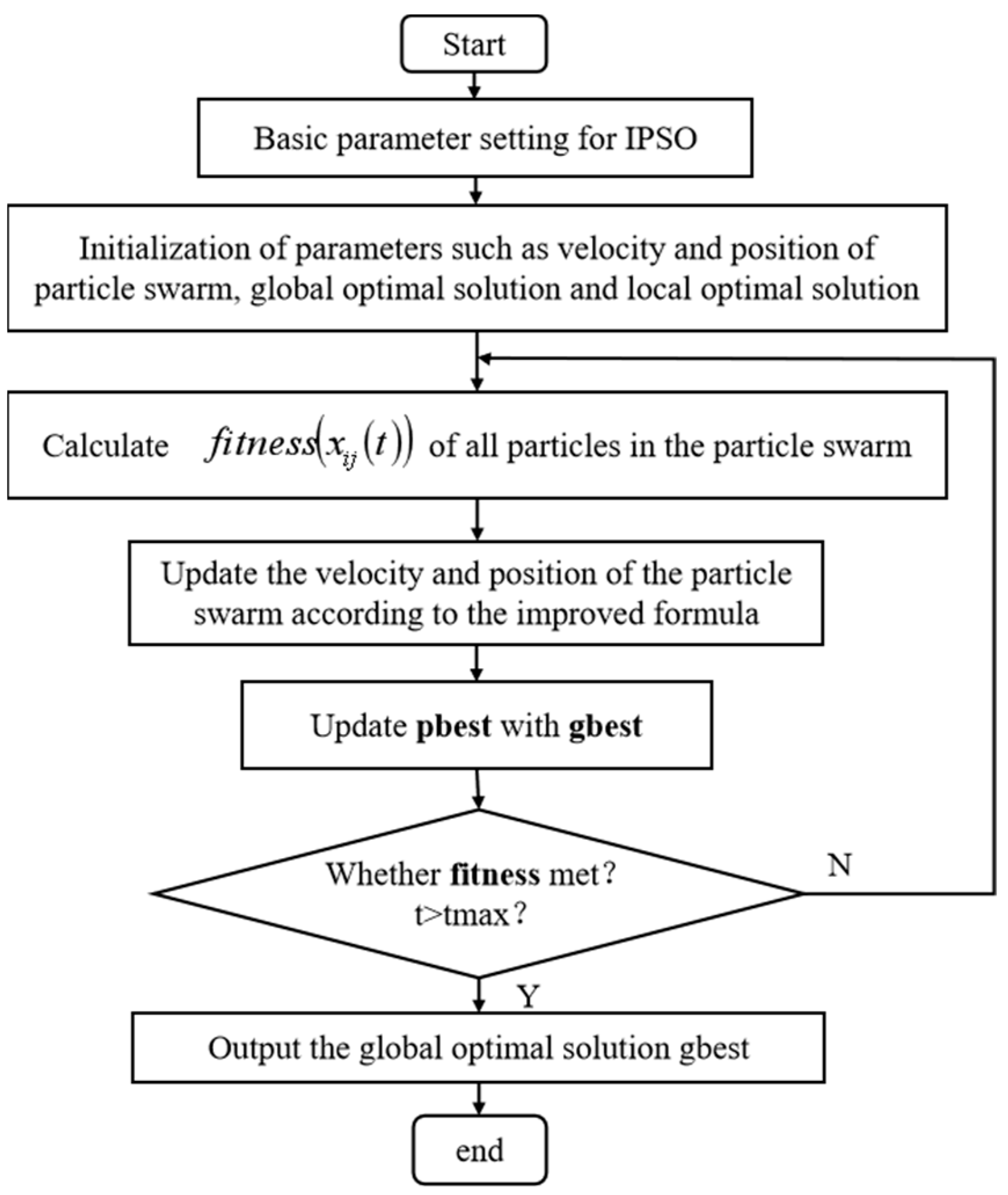
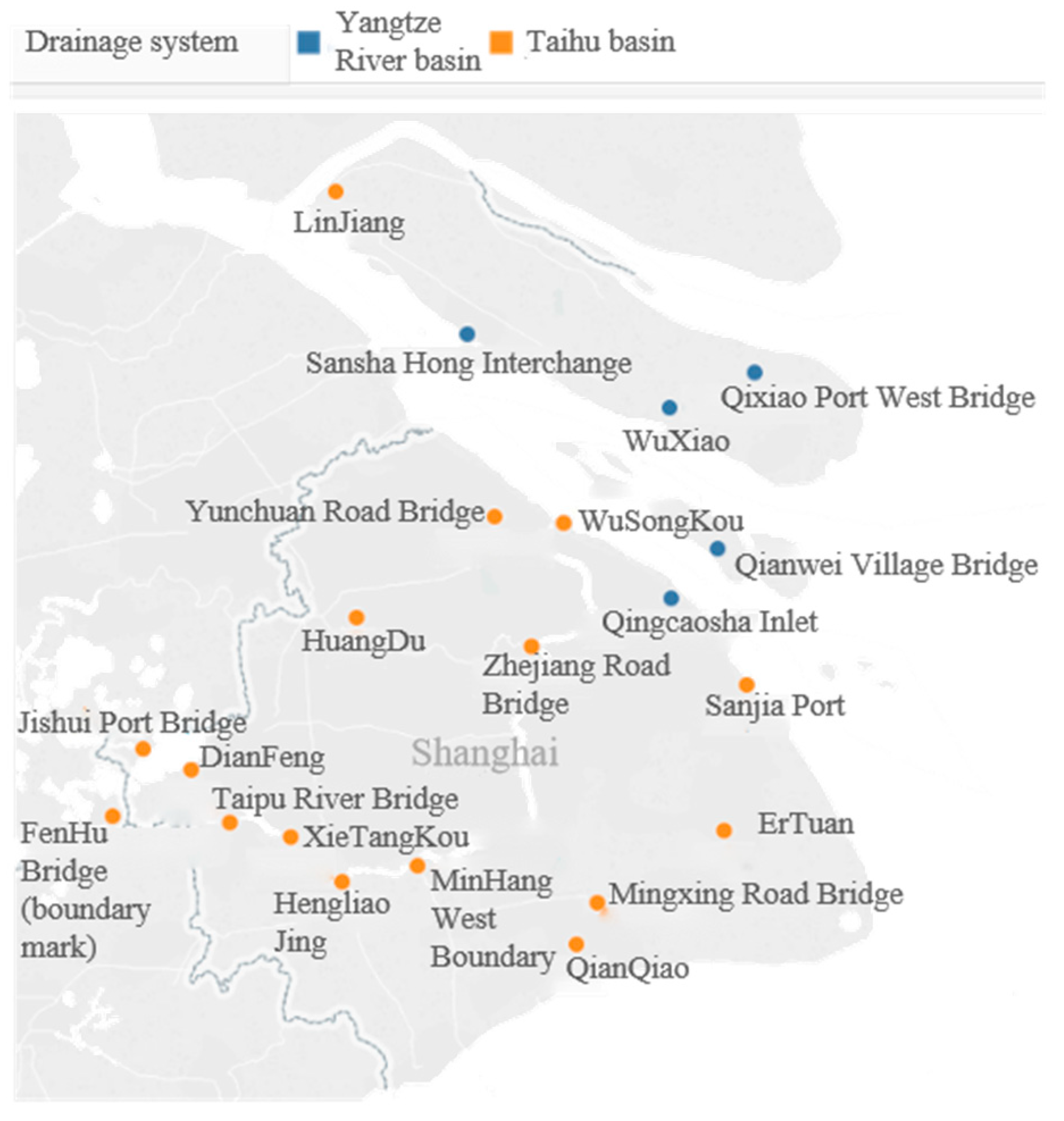
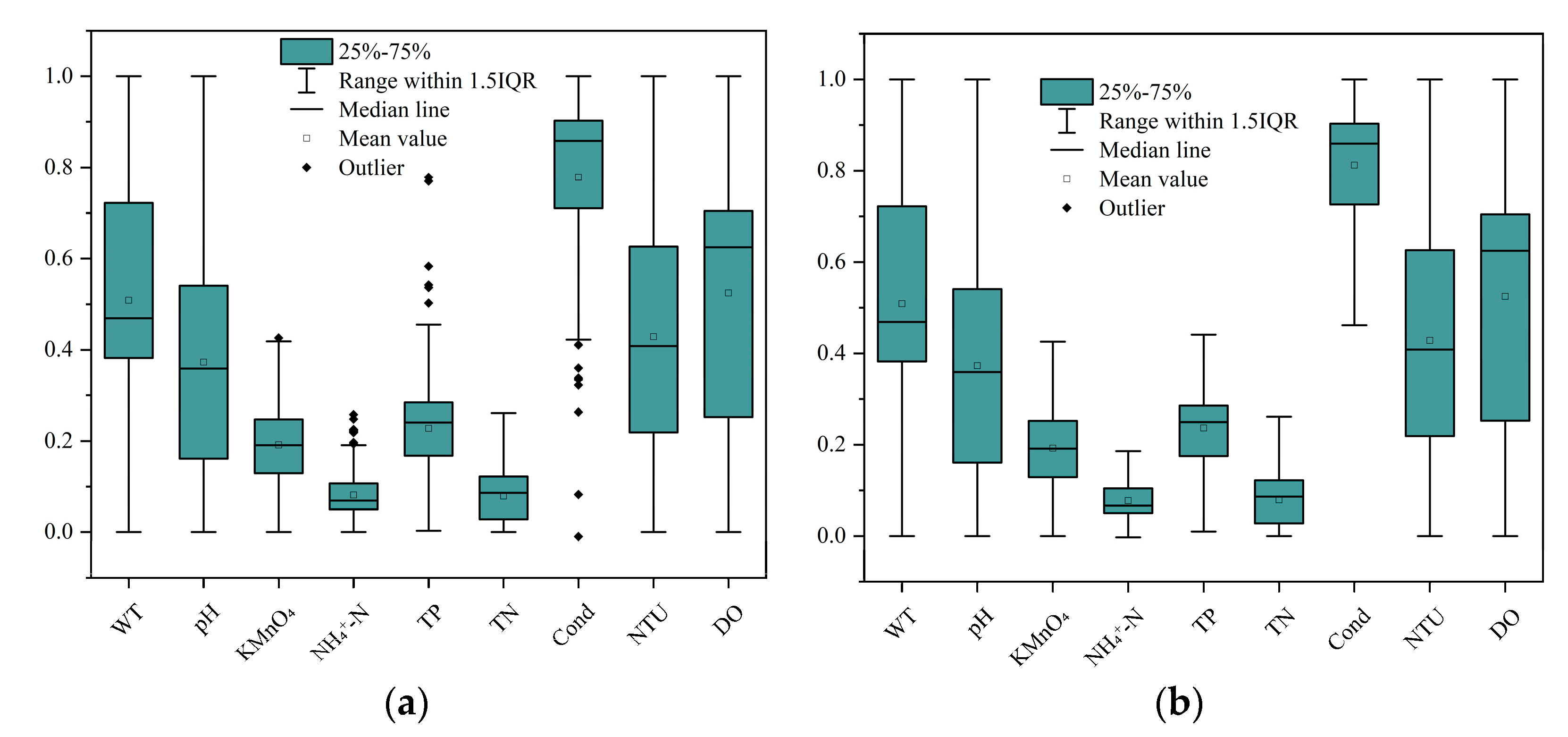
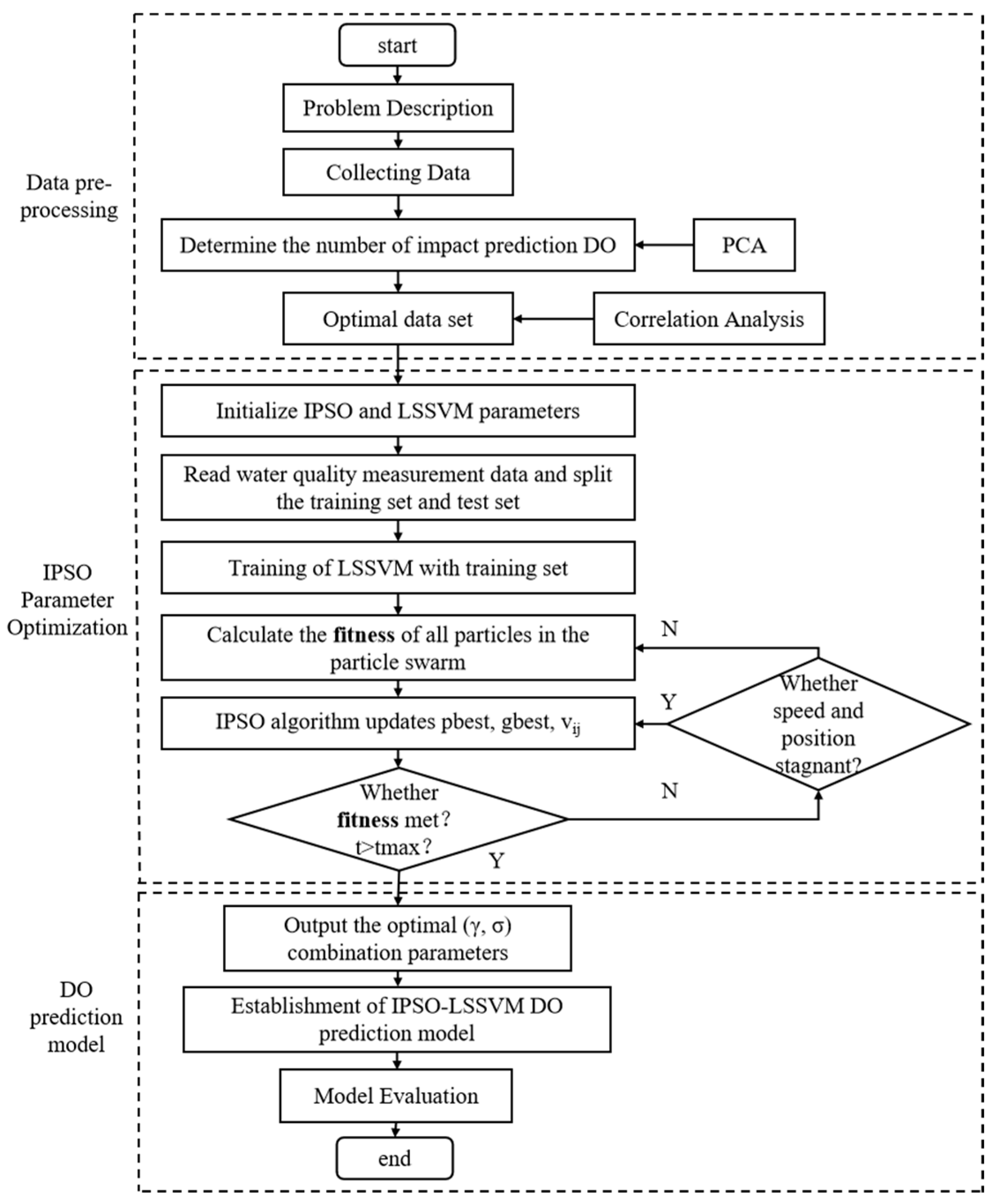
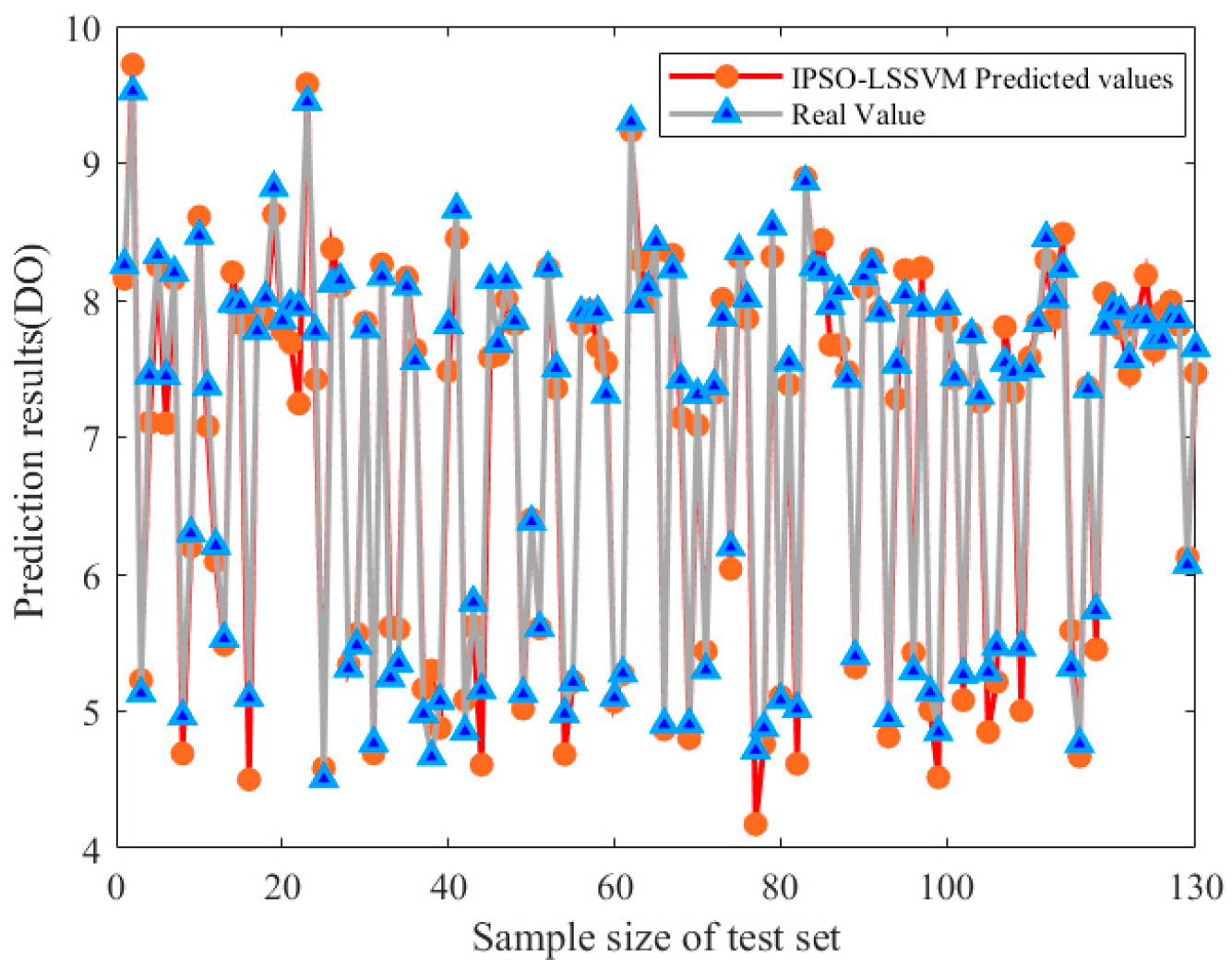

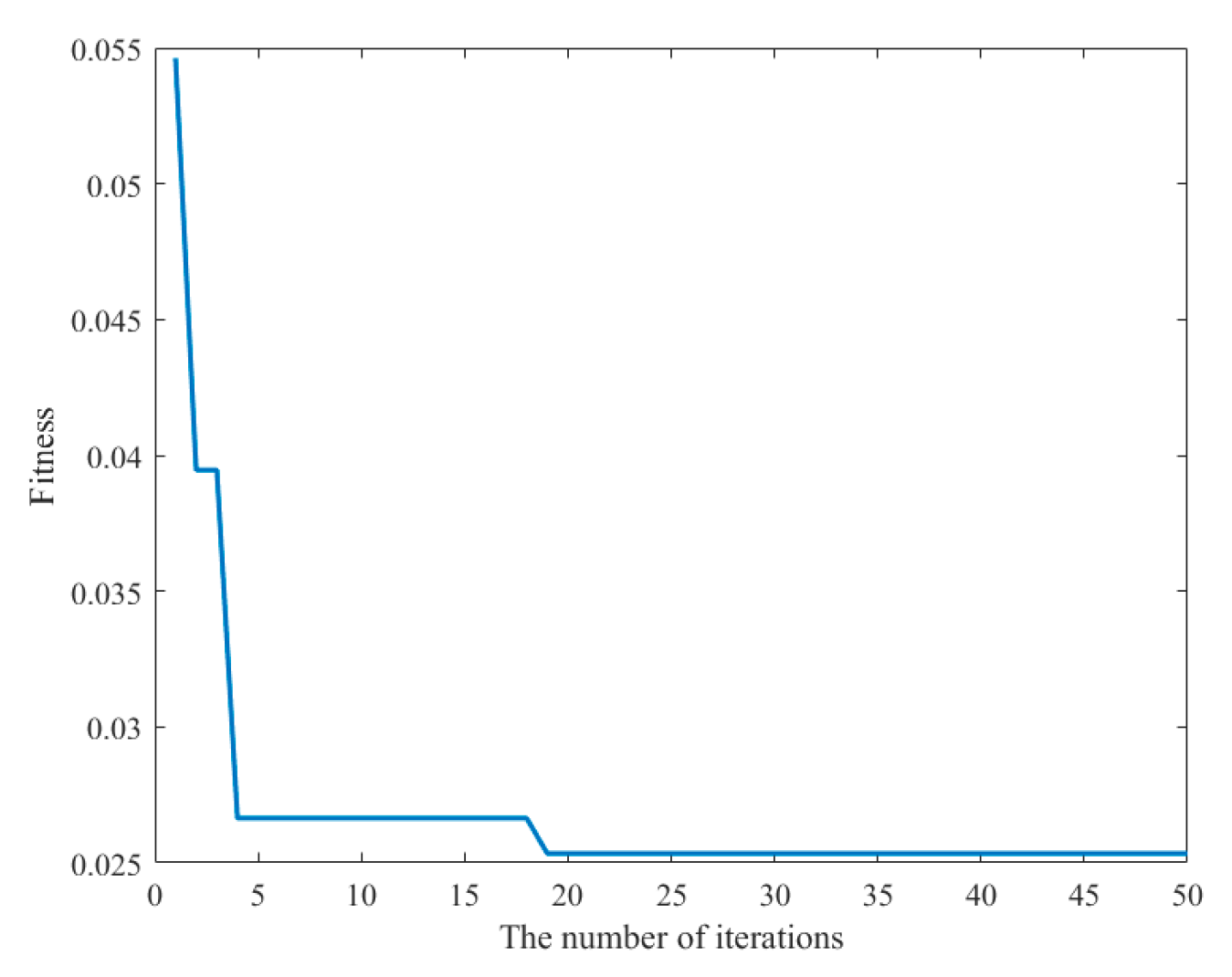
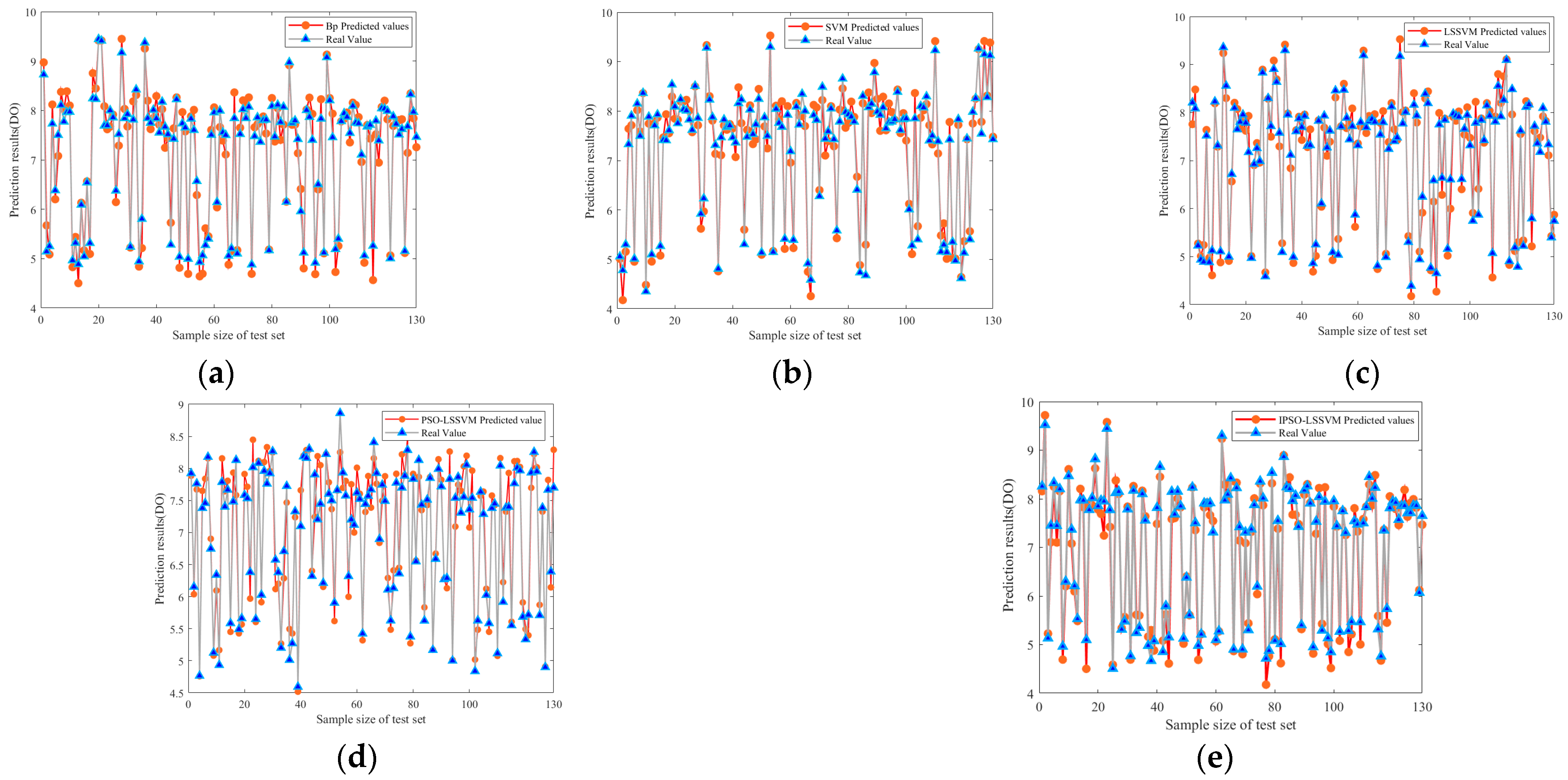

| WT | pH | KMnO4 | NH4+-N | TP | TN | Cond | NTU | DO | |
|---|---|---|---|---|---|---|---|---|---|
| WT | 1 | −0.68 ** | 0.55 ** | −0.53 ** | 0.57 ** | −0.34 ** | −0.64 ** | 0.48 ** | −0.91 ** |
| pH | –0.68 ** | 1 | −0.37 ** | 0.31 ** | −0.36 ** | −0.09 | 0.66 ** | −0.07 | 0.78 ** |
| KMnO4 | 0.55 ** | −0.37 ** | 1 | −0.12 * | 0.62 ** | −0.35 ** | −0.38 ** | 0.70 ** | −0.62 ** |
| NH4+-N | −0.53 ** | 0.31 ** | −0.12 * | 1 | −0.14** | 0.27 ** | 0.25 ** | −0.18 ** | 0.39 ** |
| TP | 0.57 ** | −0.36 ** | 0.62 ** | −0.14 ** | 1 | −0.38 ** | −0.50 ** | 0.62 ** | −0.64 ** |
| TN | −0.34 ** | −0.09 | −0.35 ** | 0.27 ** | −0.38 ** | 1 | 0.15 ** | −0.62 ** | 0.20 ** |
| Cond | −0.64 ** | 0.66 ** | −0.38 ** | 0.25 ** | −0.50 ** | 0.15 ** | 1 | –0.20 ** | 0.76 ** |
| NTU | 0.48 ** | –0.07 | 0.70 ** | –0.18 ** | 0.62 ** | –0.62 ** | –0.20 ** | 1 | –0.45 ** |
| DO | –0.91 ** | 0.78** | –0.62** | 0.39 ** | –0.64 ** | 0.20 ** | 0.76 ** | –0.45 ** | 1 |
| Principal Component | Eigenvalue | Variance Contribution Rate (%) | Accumulate (%) |
|---|---|---|---|
| PC1 | 4.678 | 51.974 | 51.974 |
| PC2 | 1.686 | 18.730 | 70.703 |
| PC3 | 1.025 | 11.387 | 82.090 |
| Models | Performance Evaluation Indicators | ||||
|---|---|---|---|---|---|
| MAE | RMSE | MAPE | R2 | T/s | |
| Bp | 0.2384 | 0.2927 | 0.0364 | 0.9442 | 6.831 |
| SVM | 0.2314 | 0.2569 | 0.0322 | 0.9628 | 3.014 |
| LSSVM | 0.2013 | 0.2559 | 0.0294 | 0.9648 | 3.303 |
| PSO-LSSVM | 0.2075 | 0.2233 | 0.0291 | 0.9733 | 6.401 |
| IPSO-LSSVM | 0.1811 | 0.2396 | 0.0283 | 0.9710 | 6.107 |
| PCA-Bp | 0.2124 | 0.2679 | 0.0342 | 0.9611 | 5.667 |
| PCA-SVM | 0.2014 | 0.2472 | 0.0311 | 0.9689 | 2.917 |
| PCA-LSSVM | 0.1814 | 0.2467 | 0.0276 | 0.9699 | 2.63 |
| PCA-PSO-LSSVM | 0.1714 | 0.2255 | 0.0268 | 0.9743 | 6.071 |
| PCA-IPSO-LSSVM | 0.1702 | 0.2221 | 0.0267 | 0.9761 | 6.003 |
Disclaimer/Publisher’s Note: The statements, opinions and data contained in all publications are solely those of the individual author(s) and contributor(s) and not of MDPI and/or the editor(s). MDPI and/or the editor(s) disclaim responsibility for any injury to people or property resulting from any ideas, methods, instructions or products referred to in the content. |
© 2023 by the authors. Licensee MDPI, Basel, Switzerland. This article is an open access article distributed under the terms and conditions of the Creative Commons Attribution (CC BY) license (https://creativecommons.org/licenses/by/4.0/).
Share and Cite
Li, Y.; Li, X.; Xu, C.; Tang, X. Dissolved Oxygen Prediction Model for the Yangtze River Estuary Basin Using IPSO-LSSVM. Water 2023, 15, 2206. https://doi.org/10.3390/w15122206
Li Y, Li X, Xu C, Tang X. Dissolved Oxygen Prediction Model for the Yangtze River Estuary Basin Using IPSO-LSSVM. Water. 2023; 15(12):2206. https://doi.org/10.3390/w15122206
Chicago/Turabian StyleLi, Yongguo, Xiangyan Li, Caiyin Xu, and Xuan Tang. 2023. "Dissolved Oxygen Prediction Model for the Yangtze River Estuary Basin Using IPSO-LSSVM" Water 15, no. 12: 2206. https://doi.org/10.3390/w15122206
APA StyleLi, Y., Li, X., Xu, C., & Tang, X. (2023). Dissolved Oxygen Prediction Model for the Yangtze River Estuary Basin Using IPSO-LSSVM. Water, 15(12), 2206. https://doi.org/10.3390/w15122206






